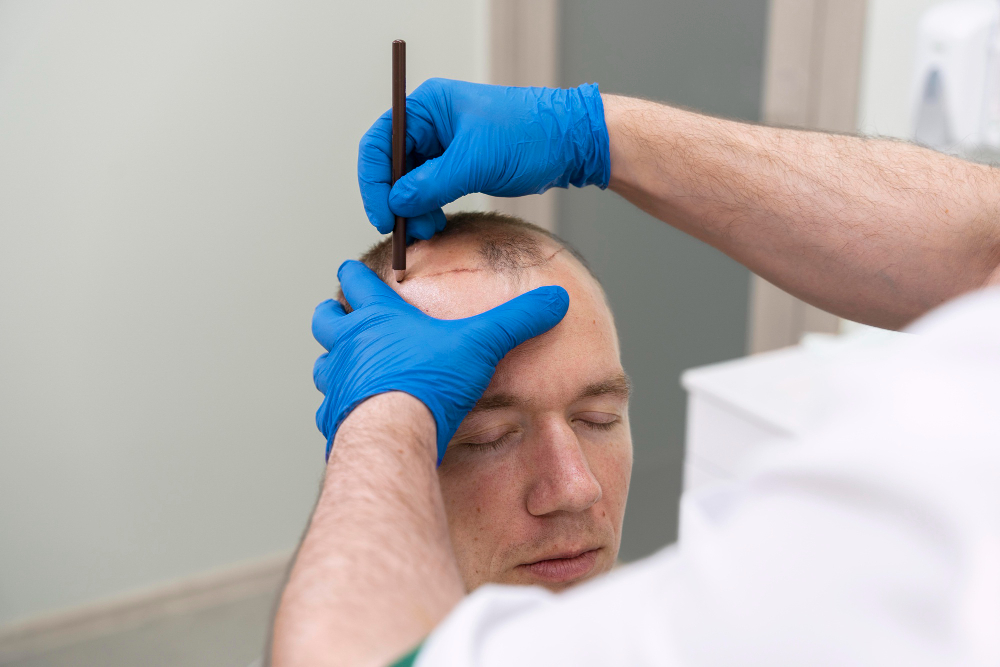DHI Hair Transplant
The newest technique for hair transplantation is the DHI Hair Transplant. With the help of the cutting-edge CHOI implanter pen, you can place your hair follicles in the balding areas without the need for a separate canal opening.

What is a DHI hair transplant?
Surgeons are using direct hair implantation (DHI) as a new technique for hair transplants to treat hair loss and thinning. “Direct hair implantation” refers to the process of extracting and implanting hair follicles into the area of hair loss directly from the donor area using a specialized implanter tool called the Choi implanter pen. It is a longer and more costly hair transplant technique than FUE since only the physician performs all the work, whereas with FUE, nurses and technicians assist more.
Hair transplants with FUE and DHI function similarly in many aspects. After being removed from the donor area, hair follicles are implanted into the recipient area. Anywhere from your mid-parting to your crown area could be your recipient area.
How direct hair implantation works
DHI Hair Transplant is an altered form of FUE hair implantation that uses a comparable technique. Hair follicles from a portion of your scalp, typically the back of your head, will be extracted by the surgeon and placed into balding areas. New hair will eventually sprout from these hair follicles.
What to normally anticipate during the procedure is as follows:
- After shaving your head, your surgeon will numb it with local anesthetic.
- Using a tool with a fine tip, the surgeon will remove hair follicles from the back of your head.
- The balding area of your scalp will have the hair follicles inserted into a pen-shaped device.
- Every site will be bandaged and treated with an antibiotic cream by the surgeon.
Depending on the quantity of hair follicles being transplanted, FUE and DHI procedures can take anywhere from eight hours to complete. A full year or more may pass before the surgical outcomes are fully apparent.
Causes of Hair Loss
Determine the type of hair loss you are experiencing before choosing a hair transplant procedure. Numerous factors, such as hormone imbalances, stress, depression, diet, medication, and personal grooming practices, can contribute to hair loss. Whatever the cause, your chances of stopping additional hair loss increase the sooner you work with a health-beauty consultant to identify the underlying problems.
Other causes include:
- Ageing
- Medication side effects
- Illness and extreme stress
- Genetics
- Inadequate hair care
Am I a suitable candidate for DHI hair transplant?
individual consultation prior to DHI grafting
Prior to the hair transplant procedure, you go through a thorough examination using the DHI Choi Pen technique. In order to make sure that there are no health issues preventing surgery at this point, the general surgery protocol is used. The donor site is examined while the required blood tests and other procedures are carried out.
For potential hair loss and patient satisfaction with hair transplantation, a thorough personal consultation based on the patient’s age and type of hair loss is crucial.
Dhi Hair Transplant Operation

Local anesthetic is used to numb the application areas prior to the DHI hair transplant procedure. One by one, in accordance with the hair transplant plan, hair follicles extracted one by one from the donor area are planted in the recipient area in the same manner after being inserted one by one into the suitable choi-tipped needle based on their thickness.
An average DHI hair transplant procedure takes six to eight hours to complete. With procedures to reduce the forehead, this time frame might be shorter. Planning ahead of hair transplantation allows for the precise timing of procedures like hair transplantation, hair growth, and unshaven hair transplantation in women.
Before the DHI hair transplant procedure at REHABTÜRK, the patient is informed of every detail of the procedure. Details regarding the recovery period are provided.
DHI vs. FUE and FUT hair transplant
Follicles from one area of your scalp are transplanted into balding areas using DHI, FUE, and FUT.
An extensive and narrow strip of skin is removed from the back of your scalp by the surgeon during FUT surgery. Along your hairline, individual hair follicles are extracted and inserted. Though it can leave a long scar, this method is typically the quickest and least expensive. If you wear your hair short, the scar might be visible, but longer hair usually covers it up.
Individual hair follicles are extracted straight from your scalp during DHI and FUE procedures. In order to insert the hair follicles during FUE, a surgeon must manually cut a number of canals in your scalp. Surgeons can simultaneously make these incisions and implant hair thanks to the DHI technique.

Although DHI and FUE don’t leave the long scar that FUT does, they usually require more time and money.
DHI providers assert that their product is the most cutting edge and potent hair treatment available. Nevertheless, research contrasting the outcomes with alternative hair treatment methods has not yet been conducted.
Hair loss can be successfully treated with any kind of FUE surgery. The question of which technique is more effective—FUE or FUT—is up for debate.
Treatment in Türkiye:
The medical staff of surgical teams, doctors, and consultants at REHABTÜRK can provide the best treatment options and free consultations, striving to stay up-to-date on the latest medical technologies and methods.
